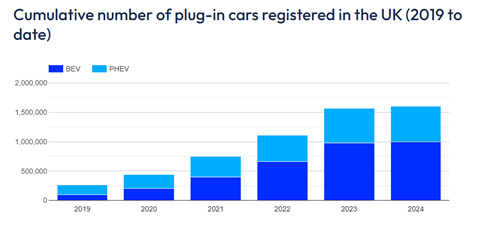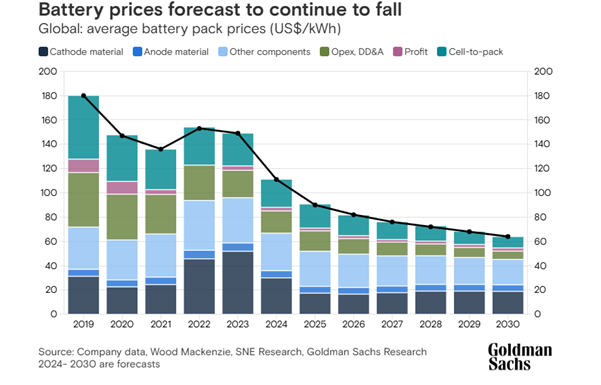
Electric car statistics – EV market insights 2024
Last updated March 8th, 2024
We’ve created a guide to the latest electric car market statistics as a resource for automotive journalists, sellers, manufacturers and consumers.
Read on for commentary on the state of the electric vehicle (EV) market in 2024 and the drive towards electrification, the latest EV sales figures (including new and used sales data) – and a roundup of the bestselling EV manufacturers.
Value your car in under 30 seconds
The current state of the EV market
- In January 2024, the millionth battery electric vehicle (BEV) joined the roads in Britain.
- According to the SMMT’s forecast, 414,000 new BEVs are expected to hit UK roads in 2024.
- A total of 20,935 BEVs, 18,744 hybrid electric vehicles (HEVs) and 11,944 plug-in hybrid electric vehicle (PHEVs) were also newly registered in January.
- This marked year-on-year (YoY) increases of 21% for BEVs, 31.1% for PHEVs – and a 1.2% decrease for HEVs.
- In January, BEV’s YoY market share grew from 13.1% to 14.7% (although this falls slightly short of the full 2023 market share of 16.5%).
- The latest EV registration data shows that although demand from the fleet and business market grew by 41% in January, private registrations fell by 25.1%.
- Meanwhile, the number of diesel registrations fell by 1,051 to 9,348 – but petrol registrations increased by 5,692 to a total of 81,905.
- In terms of market share, diesel cars fell to 7.9% (-1.4% YoY) and petrol cars fell to 57.3% (-0.4% YoY).
Source: SMMT
EV market highlights from 2023
- A total of 1.9 million new cars (across all powertrain types) were registered in 2023, reflecting a 17.9% increase from 2022. This can be partly attributed to the easing of the global semiconductor chip shortage.
- 2023 was a record year for BEV sales in the UK. According to SMMT data, a total of 314,687 BEVs were registered throughout the year (accounting for 16.5% of all new car sales).
- BEV sales are now second only to petrol models in the UK.
- A total of 141,311 PHEVs were registered in 2023 (accounting for 7.4% of all new car sales).
Source: SMMT
Challenges and solutions in 2024
- The SMMT has stated that the volatility in BEV supply is set to continue, as manufacturers rush to adjust product allocation following a last-minute resolution of UK/EU rules of origin.
- In December 2023, the UK Government finalised a deal with the EU, extending trade rules on EVs until the end of 2026. Their agreement postpones ‘rules of origin’ requirements and the imposition of 10% tariffs on EVs.
- The UK is now the only major market with an end-of-sale date for Internal Combustion Engine (ICE) vehicles (and a mandated zero-emission vehicle market share) but no significant electrification incentives for consumers. In July 2023, the proposed ICE ban deadline was pushed back from 2030 to 2035.
- SMMT CEO Mike Hawes has urged the UK Government to temporarily halve VAT on new BEV purchases as part of their Budget next month.
- This would cost the Treasury an average of £1,125 (less than the cost of the previous plug-in car grant [PiCG] that was withdrawn in June 2022).
- According to the SMMT, this move would put more than 250,000 new EVs on the road by the end of 2026, in addition to those already forecast.
Source: SMMT, Fleet News
UK BEV sales (2018-2023)
New BEV sales (by registrations) increased by 17.7% in 2023, compared with the previous year.
Annual BEV registrations have grown by 1929% since 2018.
| Year | Number of BEV registrations |
|---|---|
2023 |
314,687 |
2022 |
267,203 |
2021 |
190,727 |
2020 |
108,205 |
2019 |
37,850 |
2018 |
15,510 |
Source: SMMT
Different types of EVs
Here is a quick explainer on the various types of EV on the market:
Battery Electric Vehicles (BEVs)
Unlike the other hybrid variants on the market, BEVs are powered solely by an electric battery. Most BEVs have electric ranges between 100-300 miles.
(Whilst 200 miles or above is broadly considered a good range, a range of 100 miles may be sufficient depending on your daily commute.)
Plug-in Hybrid Electric Vehicles (PHEVs)
PHEVs are powered by a combination of an electric battery and a fossil fuel (petrol or diesel) engine.
PHEV batteries are smaller compared to those found in BEVs and typically provide a range of 15-40 miles.
However, some premium PHEVs do provide larger ranges, such as the Toyota RAV4 PHEV (46 miles), BMW 2 Series 225e (56 miles), the Mercedes-Benz GLE 350de (66 miles) - and the Polestar 1 (93 miles).
Just like a BEV, a PHEV can be plugged in to charge its electric battery.
Hybrid Electric Vehicles (HEVs)
A HEV is powered by a petrol and diesel engine, which charges a battery capable of propelling an electric drivetrain.
No manual charging is required with a HEV. Instead, the electric battery is recharged a little each time the driver brakes. This process is known as ‘regenerative braking’.
Unlike a PHEV, HEVs are not designed to be capable of running on electric power alone.
How do EVs work?
EVs are powered by one or more electric motors rather than an ICE engine. These motors are powered by a rechargeable battery, which can be replenished by plugging the vehicle into an electric charger.
What factors affect EV performance?
Your real-world electric range may differ from the advertised figure (which often reflects a best-case scenario). Factors that affect EV performance include your driving style, weather conditions - and the degree to which features such as the in-car heating and air conditioning are used.
Smart energy recovery technology
EVs utilise technology that converts kinetic energy into electricity whilst braking or travelling uphill, automatically topping up the battery.
Charging
- Fully charging an EV battery with a standard 7kW wallbox charger typically takes 8-9 hours.
- However, most EVs have a ‘rapid charge’ capability that can use higher voltage chargers to achieve an 80% charge in around 40 minutes.
- The cost of charging an electric car is largely dictated by energy prices.
How many EV charging stations are in the UK?
At the end of January 2024, there were 55,301 EV charge points in the UK (across 31,445 locations) - a 46% increase from January 2023.
This figure refers to the UK’s public EV charging infrastructure and does not include home and workplace chargers (estimated to be more than 700,000).
Source: Zapmap
How has the UK’s EV market share grown over time?
- In 2016, a mere 0.4% of all new vehicles registered in the UK were BEVs.
- In 2023, the market share for BEVs hit an all-time high of 16.5% - and a further 7.4% of cars registered were PHEVs, bringing the total market share for plug-in vehicles to 23.9%.
- These figures reflect a growing demand for EVs – and a reduction in the demand for ICE cars (particularly diesel models).
Source: Zapmap
Popularity of different EV types
The table below shows the widening gap between BEV and PHEV sales over time – and their combined market share:
2019 |
2020 |
2021 |
2022 |
2023 |
|
|---|---|---|---|---|---|
BEV marketshare |
1.7% |
6.6% |
11.6% |
16.6% |
16.5% |
PHEV marketshare |
1.5% |
4.1% |
7.0% |
6.3% |
7.4% |
Combined marketshare |
3.2% |
10.7% |
18.6% |
22.9% |
23.9% |
Source: SMMT
UK new electric car sales statistics
According to the latest SMMT report, in January 2024, there were around 999,000 BEVs and 600,000 PHEVs registered in the UK.
However, it was later confirmed that the millionth BEV has been registered, meaning there are now 1,600,000 plug-in vehicles on the roads.

Source: SMMT, Zapmap
Bestselling EVs in the UK for 2024 so far
The list below shows the bestselling EVs in the UK, according to vehicle registration data from January 2024:
- Kia Sportage - 4,239
- Ford Puma – 4,201
- Nissan Qashqai – 4,008
- MG HS – 3,413
- BMW 1 Series – 3,204
- MINI – 3,079
- Audi A3 – 2,648
- Volkswagen Golf – 2,456
- Nissan Juke – 2,421
- Hyundai Tucson – 2,373
Source: SMMT
Bestselling EVs in 2023
Here is the list of the bestselling EVs in 2023 (by number of registrations). The Tesla Model Y has topped the list for a second consecutive year:
- Tesla Model Y (35,899)
- MG4 (21,715)
- Audi Q4 e-tron (16,757)
- Tesla Model 3 (13,536)
- Polestar 2 (12,542)
- Volkswagen ID.3 (10,295)
- Kira Niro EV (10,084)
- BMW i4 (8,940)
- .
- Volkswagen ID.4 (8,495)
- Skoda Enyaq (8,136)
Source: SMMT
Bestselling EVs in 2022
In 2022, Tesla Model Y took the top spot from another Tesla... the Model Y.
- Tesla Model Y (35,551)
- Tesla Model 3 (19,071)
- Kia e-Niro (11,197)
- VW ID.3 (9,832)
- Nissan Leaf (9,178)
- MINI Electric (7,425)
- Polestar 2 (7,345)
- MG5 (7,030)
- BMW i4 (6,699)
- Audi Q4 e-tron (6,594)
Source: SMMT
BEV registrations in 2023 by month
| Month | Number ofnew BEV registrations (Source: SMMT) |
|---|---|
January |
17,294 |
February |
12,310 |
March |
46,626 |
April |
20.522 |
May |
24,513 |
June |
31,700 |
July |
23,010 |
August |
17,243 |
September |
45,323 |
October |
23,943 |
November |
24,359 |
December |
27,841 |
How many electric cars were registered in 2023?
2023 was a record year for BEV sales in the UK, with a total 314,687 registrations.
How many BEVs are there in the UK?
According to the latest SMMT data, as of January 2024, there were 990,000 BEVs on the road.
Although no more current figures were available at the time of publication, it has since been confirmed that the millionth BEV has been registered in the UK.
Used electric car sales
- According to the latest SMMT data, in Q3 of 2023, a total of 1,884,160 used cars were sold across all powertrain types, marking a 5.5% YoY increase.
- BEVs achieved a record 1.8% market share (up from just 1.0% in 2022). Sales grew by 99.9%, with a total of 34,021 units sold.
- PHEV and HEV sales also grew by 34.6% and 46.4% respectively. As a result, plug-in sales have increased by 70.9% to secure a 2.8% market share.
(Source: SMMT)
Improving battery technology and the future of EVs
According to renewable energy price matching site, GreenMatch, several promising developments in EV battery technology could be pivotal in driving EV adoption in 2024 and beyond:
- Chinese start-up Gotion High-tech have announced plans to mass produce a new lithium manganese iron phosphate (LMFP) battery in 2024.
- If this battery can deliver its promised range of 621 miles, it could be the key to assuaging range anxiety among prospective EV buyers.
- General Motors is also researching lithium-metal battery chemistry with a view to increasing range and ultimately lowering the cost of EVs.
- From 2026, Toyota will introduce new battery technology offering a range of 497 miles. This increased range will be achieved by reducing battery weight and energy density, in addition to improving aerodynamics for the cars in their range.
- These advances in EV technology could help to drive increased adoption in the years to come. Investment bank and financial services company Goldman Sachs forecast that EV battery prices will fall by 40% by 2025, which could lead to a significant reduction in EV prices over the coming years.


